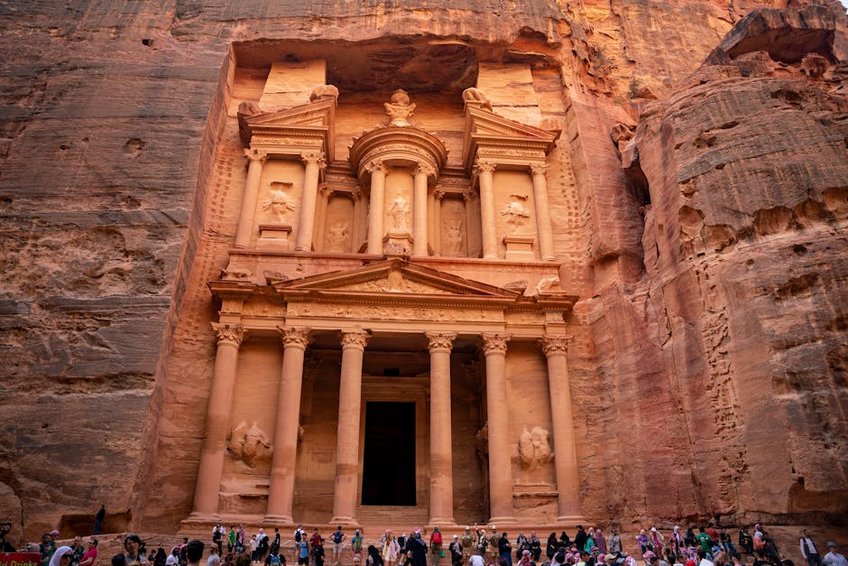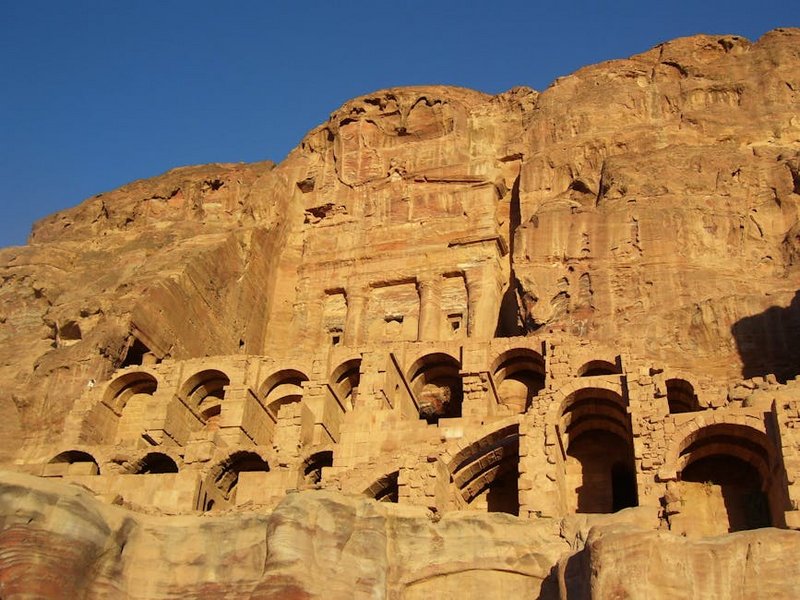Petra Ancient City (Jordan) – The Ultimate Travel Guide to the Rose-Red Wonder
Welcome to the magnificent Petra Ancient City (Jordan), a UNESCO World Heritage Site and one of the New Seven Wonders of the World that will leave you absolutely breathless. Carved directly into vibrant red, white, pink, and sandstone cliff faces, this archaeological marvel represents the incredible ingenuity of the Nabataean civilization that flourished over 2,000 years ago. As you walk through the narrow Siq canyon, with towering walls that seem to touch the sky, you’ll feel the anticipation building until that magical moment when the Treasury reveals itself in all its glory. Petra Ancient City (Jordan) isn’t just about one famous facade though – it’s an expansive complex of tombs, temples, and ancient infrastructure that spans over 100 square miles, offering days worth of exploration. Whether you’re a history enthusiast, an adventure seeker, or simply someone who appreci breathtaking beauty, this destination promises an experience that will stay with you forever. The journey through Petra connects you not just with ancient history but with the very essence of human achievement and artistic expression.
Petra Ancient City (Jordan) Essential Information – What Every Traveler Should Know
Before embarking on your journey to Petra Ancient City (Jordan), understanding the historical context and practical logistics will significantly enhance your experience. The Nabataeans, originally nomadic Arabs, established Petra as their capital around the 4th century BCE, creating an ingenious system of water conservation and rock-cut architecture that still astonishes engineers today. The city thrived as a major trading hub along the incense routes, connecting Arabia, Egypt, and Syria-Mediterranean. What makes Petra particularly fascinating is how the Nabataeans blended influences from various cultures they encountered through trade, creating a unique architectural style that incorporates Assyrian, Egyptian, Greek, and Roman elements. Today, only about 15% of Petra has been uncovered, with ongoing excavations continuously revealing new discoveries about this sophisticated ancient civilization.
Historical Significance and Cultural Importance
- Petra served as the capital of the Nabataean Kingdom from approximately 400 BCE to 106 CE, showcasing advanced engineering with water conduit systems and dramatic tomb facades
- The city appears in numerous historical records and was “rediscovered” by Swiss explorer Johann Ludwig Burckhardt in 1812, bringing it to Western attention
- Petra represents one of the most valuable archaeological sites globally, offering insights into ancient trade routes, astronomy, and hydraulic engineering techniques
- Budget travelers can manage with $50-70 USD per day by staying in hostels in Wadi Musa, bringing water and snacks, and walking instead of hiring transportation within the site
- Mid-range visitors should budget $100-150 USD daily for comfortable hotels, restaurant meals, guided tours, and occasional camel or horse rides within Petra
- Luxury experiences including 5-star accommodation, private guides, and special experiences like Petra by Night can cost $250-400+ USD per day
- Official Petra Development and Tourism Region Authority
- UNESCO World Heritage Centre – Petra
Practical Visitor Information and Requirements
When planning your visit to Petra Ancient City (Jordan), you’ll need to consider several practical aspects. The site is open from 6:00 AM to 6:00 PM during summer months (April-September) and 6:00 AM to 4:00 PM in winter (October-March), with slightly shorter hours during Ramadan. The entrance fee might seem steep compared to other attractions, but considering the sheer scale and significance of Petra, it represents excellent value. A one-day ticket costs approximately $70 USD, while a two-day pass is around $75 USD, and three-day access is about $80 USD. Jordanian citizens pay significantly less, and if you purchase the Jordan Pass online before arrival (which includes your visa fee and entry to multiple attractions), you’ll save considerably on admission costs while streamlining your entry process.

Petra Ancient City (Jordan) Planning Your Trip – Timing, Budget, and Preparation
Proper planning can transform your Petra Ancient City (Jordan) experience from good to extraordinary. The ideal duration for most travelers is two full days, allowing you to explore at a comfortable pace without rushing between highlights. If you’re particularly interested in archaeology or photography, consider extending to three days to capture the changing light on the rose-red stone and explore lesser-known areas. Spring (March to May) and autumn (September to November) offer the most pleasant weather conditions, with daytime temperatures ranging from 68°F to 86°F (20°C to 30°C). Summer months can be extremely hot, often exceeding 104°F (40°C), making early morning and late afternoon visits essential. Winter brings cooler temperatures and occasional rain, but fewer crowds and dramatic skies create spectacular photographic opportunities.
Best Time to Visit Petra Ancient City (Jordan)
The optimal time to experience Petra Ancient City (Jordan) is during the shoulder seasons of spring (March to May) and autumn (September to November) when temperatures are moderate and crowds are manageable. During these months, daytime temperatures typically range from 65°F to 85°F (18°C to 29°C), perfect for extensive walking and climbing. February can be surprisingly beautiful with occasional dustings of snow creating stunning contrasts against the red rock, though some paths might be slippery. June through August brings intense heat, often reaching 100°F+ (38°C+), making early morning entries essential. December and January see the fewest visitors but require warm clothing as temperatures can drop to freezing at night, though days remain pleasant for exploration around 50°F to 60°F (10°C to 15°C).
Budget Planning and Costs for Petra
Essential Preparation Checklist
Preparing adequately for your Petra Ancient City (Jordan) adventure will significantly enhance your comfort and enjoyment. Start breaking in comfortable walking shoes at least two weeks before your trip – you’ll be walking 5-10 miles daily over uneven terrain. Pack a day bag with at least 2 liters of water per person, high-energy snacks, sunscreen (SPF 50+), a wide-brimmed hat, and polarized sunglasses to combat the intense reflection from the sandstone. Download offline maps and research apps before arrival since cellular service can be unreliable within the canyon. If you plan to photograph the Treasury facade, bring a wide-angle lens (at least 24mm) to capture its full grandeur. Lastly, carry small Jordanian dinar notes for tips, small purchases, and bathroom facilities throughout the site.
Petra Ancient City (Jordan) Top Attractions and Activities – Beyond the Treasury
While the Treasury (Al-Khazneh) is undoubtedly Petra’s most iconic structure, the site contains countless other breathtaking attractions that deserve your attention. The entire city unfolds like an ancient treasure map, with each turn revealing new wonders. From the dramatic Monastery perched high on the mountain to the Royal Tombs with their intricate facades, you’ll find yourself constantly amazed by the scale and sophistication of Nabataean engineering. The Roman Theater, capable of seating 3,000 spectators, demonstrates how later civilizations adapted and utilized the existing structures. For the adventurous, the hike to the High Place of Sacrifice offers not only fascinating religious sites but panoramic views that will make every strenuous step worthwhile. Remember that Petra reveals its true magic to those who venture beyond the well-trodden path to the Treasury.
Must-See Highlights and Iconic Structures
Your first view of the Treasury through the narrow Siq canyon will undoubtedly take your breath away, but don’t rush past this magnificent facade. Take time to examine the intricate carvings and imagine the ancient traders arriving here after long desert journeys. Continue to the Street of Facades where rows of Nabataean tombs carved into the cliff face demonstrate varying architectural styles and wealth levels. The Roman Theater, surprisingly carved rather than built, showcases the adaptation of Nabataean structures to Roman tastes after the annexation of 106 CE. The Royal Tombs, including the Urn Tomb, Silk Tomb, and Corinthian Tomb, display increasingly elaborate facades that indicate the status of those buried within. Finally, make the climb to the Monastery (Ad-Deir), which though similar in design to the Treasury, is significantly larger and offers spectacular mountain views.
Hidden Gems and Local Favorites
Beyond the main trail, Petra Ancient City (Jordan) conceals numerous lesser-known treasures that reward the curious explorer. The Lion Triclinium, featuring a carved lion above its entrance, served as a ritual dining room and offers a quiet alternative to more crowded sites. The Garden Temple complex reveals sophisticated water management systems with channels and cisterns that enabled life in this arid environment. For a truly unique experience, follow the path to the High Place of Sacrifice at sunrise or sunset when the light transforms the entire landscape into a painter’s palette of reds and oranges. The recently opened Little Petra (Siq al-Barid) located just north of the main site features similar rock-cut architecture with beautiful frescoes and far fewer visitors, providing a more intimate experience of Nabataean culture.
Petra Ancient City (Jordan) Practical Travel Information – Transportation and Accommodation
Navigating your way to and around Petra Ancient City (Jordan) requires some planning but is remarkably straightforward once you understand the options. Most international travelers fly into Queen Alia International Airport in Amman, Jordan’s capital located approximately 3 hours north of Petra. From there, you can rent a car (highly recommended for flexibility), take a JETT bus (approximately $15 USD one way), or hire a private driver ($80-120 USD one way). The nearby town of Wadi Musa serves as the gateway to Petra, offering accommodation ranging from budget hostels to luxury resorts. Within the archaeological site itself, prepare for extensive walking – comfortable footwear is non-negotiable. Alternative transportation like horse-drawn carriages, camels, and donkeys are available but consider the ethical implications and negotiate prices firmly beforehand.
| Transportation Type | Details and Recommendations | Price Range (USD) |
|---|---|---|
| Rental Car | Best for flexibility, available at Amman airport, requires international driving permit | $35-70 per day |
| Private Driver | Comfortable door-to-door service, can be arranged through hotels | $80-150 one way from Amman |
| JETT Bus | Reliable coach service with scheduled departures from Amman | $15-20 one way |
| Local Taxis | Available throughout Jordan, always negotiate price before entering | $50-80 from Amman |


